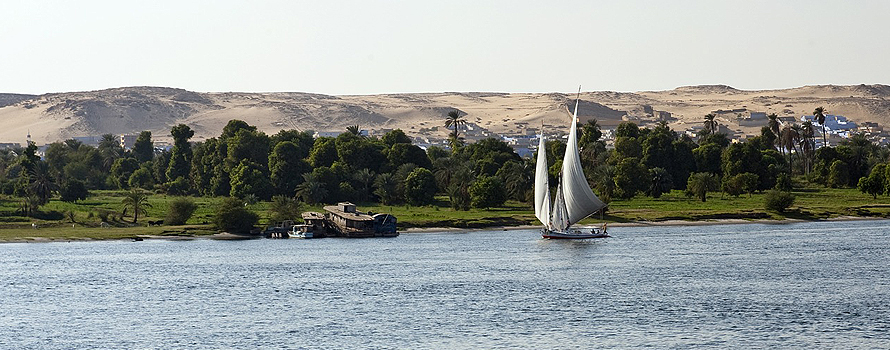
▲Lower course of the Nile River, in Egypt [Pixabay]
ANALYSIS / Albert Vidal [Spanish version]
The disputes over the control of rivers, lakes and, definitely, water, are especially alive and will intensify in a near future, since, according to the World Health Organization, in 2025; half of the world population will live in areas with water scarcity. Currently, the countries with the biggest water reserves are Brazil, Russia, USA, Canada, China, Colombia, Indonesia, Peru, India and the Democratic Republic of the Congo. Most of the water available is either located underground, or concentrates in aquifers and superficial waters (rivers and lakes). The aquifers with the largest water reserves are the Nubian Sandstone Aquifer System (under the Sahara Desert), the Great Artesian Basin (in Australia) and the Guaraní Aquifer (in South America). However, there are some rivers whose importance is exceptional, because of the large amount of population and industries that depend on them. Problems arise when these rivers do not belong to a single state, but are contiguous rivers or cross-border ones, which cause disputes between some states.
Sources of tension in Asia
Asia is being especially affected by this problem. Currently, there are various tensions that revolve around water control. One of the most significant cases is the use of the Indus River water, which supports 300 million people and has caused problems between Pakistan and India. This river is a vital resource for both countries. With the independence of Pakistan, the Indus became a source of disputes. As an attempt to solve this problem, the Indus Waters Treaty (1960) was formed, which gave India the three eastern tributaries (the Sutlesh, the Ravi and the Beas) and Pakistan was given the three western rivers (the Indus, the Jhelum and the Chenab). But due to water shortages, Pakistan has recently protested against the construction of dams in the Indian part of the river (upstream section of the river, which is located in the Kashmir administered by India), which restrict the supply of water to Pakistan and reduce the flow of the river. India, for its part, defends itself by saying that these projects are contemplated in the Treaty; even then, the tensions do not seem to decrease. For this reason, Pakistan has asked the World Bank to appoint the president of an international arbitration tribunal, in order to resolve this conflict. This problem of water reserves is the core of the confrontation in Kashmir: without an adequate supply, Pakistan would not take long to become a desert.
|
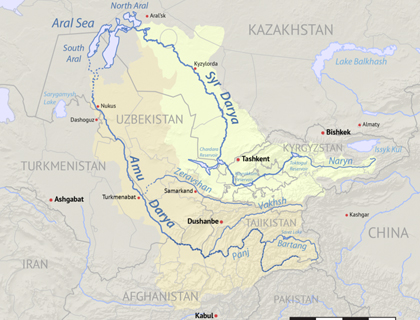
The Syr Darya and Amu Darya basins [Wikimedia Commons–Shannon I]
|
|
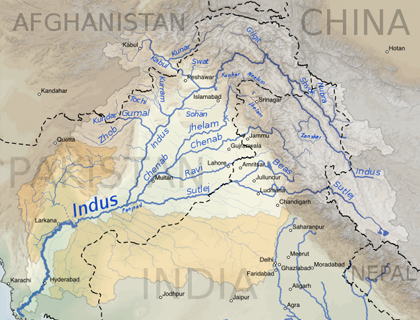
The Indus River basin [Wikiwand]
|
In Asia there is also the dispute over the Mekong River, which crosses Cambodia, Vietnam, Laos and Thailand. This conflict revolves around the construction of dams by various countries, as well as the exploitation of the resources provided by the Mekong River. The construction of 11 dams along the river is planned, which would produce a large amount of electricity and would be beneficial for some countries, but could threaten the food security of millions of people. The affected countries (Cambodia, Vietnam, Laos and Thailand) formed in 1995 the Mekong River Commission (MRC). This commission was created in order to promote dialogue and foster the fair and equitable use of river waters. The MRC has mediated between countries several times; in 2010 for the construction of a dam by Laos and Thailand, and the same situation occurred in 2013. The talks have not been very effective, and there are concerns about the lives of millions of people, who could be affected if the conflict intensifies.
The ineffectiveness of this organization could be summarized as follows: decisions on the construction of the dams are taken directly without submitting them to the MRC, and the construction companies put such pressure on the governments, that it is very difficult to carry out evaluations on the environmental impacts. Furthermore, as it is not a binding treaty, members end up ignoring its guidelines and prefer to "cooperate" in a broad sense. In any case, the talks are still going on; although, for the time being, the MRC does not seem capable of taking on the weight of the negotiations. This gives the conflict an uncertain and dangerous future.
A third focus of friction is that which affects the ex-Soviet region of Central Asia. During the Cold War, these regions shared resources as follows: republics with mountainous terrain (Tajikistan and Kyrgyzstan) had abundant water, and supplied it to the republics downstream (Kazakhstan, Turkmenistan and Uzbekistan) to generate electricity and irrigate the crops. In turn, the republics downstream supplied gas and coal to Tajikistan and Kyrgyzstan during the winter. But when the USSR collapsed, all of that changed. Water shortages and power cuts started being common, as these independent countries decided to stop sharing water and energy. As the think-tank International Crisis Group proclaims, "The root of the problem is the disintegration of the resource-sharing system the Soviet Union imposed on the region until its collapse in 1991."
Thus, Kyrgyzstan and Tajikistan have decided to build hydroelectric dams on the Syr Darya and Amu Darya rivers to produce their own energy and face the constant blackouts (potentially lethal in winter). This, of course, will limit access to water for millions of people living in the other three republics, which has led to small-scale conflicts. Threats have also abounded, such as that of the Uzbek President Islom Karimov, who in 2012 said: "Water resources could become a problem in the future that could escalate tensions not only in our region, but on every continent ". He added: "I won’t name specific countries, but all of this could deteriorate to the point where not just serious confrontation, but even wars could be the result." Despite the threats, the projects have continued on their way, and therefore an increase in tension in the region can be expected.
|
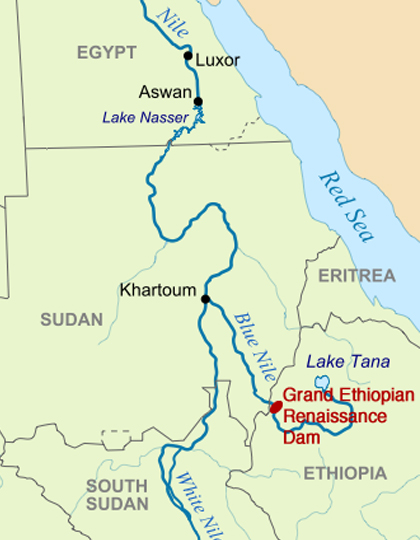
The course of the Nile River [Wikimedia Commons–Yale Environment 360]
|
|
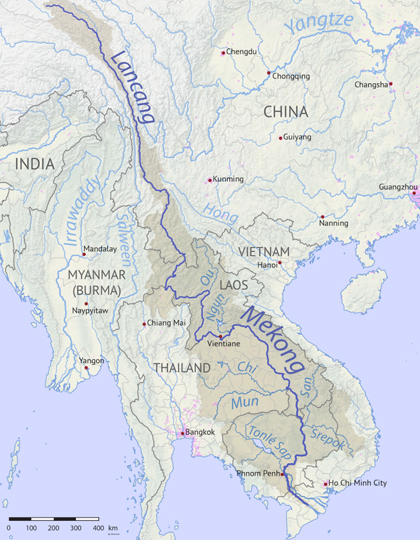
The Mekong River basin [Wikimedia Commons–Shannon I]
|
The control of the Nile
The Nile River appears as a source of tension between different African countries. To understand the existing problem, we must go back more than a century ago. Already in 1868, Egypt tried to occupy Ethiopia to take control of the Nile riverbed. In 1929 an agreement was signed during the colonial era, in which the waters of the Nile were distributed. In this agreement (which was reaffirmed in 1959), Egypt obtained most of the water for its use, while Sudan obtained only a small part. The remaining nine countries of the Nile basin were ignored in the treaty. At the same time, Egypt was allowed to build projects on the Nile River while the rest of the riparian countries were forbidden to do the same without the permission of Egypt.
In 1999, the Nile Basin Initiative was created: it was a commission entrusted with the organization of a fair distribution of the water and the resources of the Nile River. But since it did not perform as expected, in 2010 was signed, as a consequence of the unequal distribution of water, the Entebbe Agreement (by Ethiopia, Rwanda, Uganda, Kenya, Tanzania and Burundi). This agreement, deeply controversial and opposed by Egypt and Sudan, allows riparian countries to build dams and other projects without Egypt’s permission, thus breaking the restrictions imposed by the colonial treaties. In addition, this has upset the balance in the region, as Egypt and Sudan have lost the monopoly over the resources of the Nile.
It is vital to understand the geographical situation of these actors. The Nile is born in several countries, and ends up going through Sudan and Egypt, finally flowing into the Mediterranean Sea. Egypt, in particular, is a country completely dependent on the Nile River. It receives more than 90% of its fresh water from this river, and its industry and agriculture need the Nile to have any chance of survival. Until a few years ago, and because of the colonial treaties, Egypt had exercised a monopoly on the use of water in the Nile; but still, the situation is changing.
The confrontation has arisen between Egypt and Ethiopia (where the Blue Nile is born). The latter is a country with more than 100 million inhabitants, which in 2011 had a project to build a dam: the Great Ethiopian Renaissance Dam (GERD). With an investment of $4.7 billion dollars, this dam would solve the energy deficit of Ethiopia, and would eventually convert this country into a net exporter of electricity (it would produce 6,000 MW per year). The drawback is that the dam will be fed with water from the Blue Nile, a tributary of the Nile River. The danger of evaporation of more than 3 billion cubic meters per year and the reduction of the flow to fill the reserve could affect Egypt in a catastrophic way. In addition to the dangers derived from the overuse of water, the growth of the population and the demand for a better redistribution of water among the riparian countries should be taken into account.
This problem has increased tensions between Ethiopia and Egypt: in 2010 an email from an Egyptian high command was leaked on Wikileaks, stating that they were discussing military cooperation with Sudan against Ethiopia, with plans to establish a base in Sudan for the Egyptian Special Forces with the intention of attacking the GERD. Egypt also thought about supporting proxy rebel groups in Ethiopia, to destabilize the government. Anyway, we must bear in mind that Egypt has always tended to use an aggressive rhetoric towards all problems related to the Nile (source of life in Egypt, the engine of its economy), but the nation of the Pharaohs is not in a position to launch a military offensive against Ethiopia, since their domestic problems have exhausted the country, losing its position of clear predominance in the region.
But the future is not so bleak. In March 2015, a preliminary agreement was signed in Khartoum between Egypt, Ethiopia and Sudan on the Renaissance dam and on the water allocation. Such agreement accepted Ethiopia's right to build the dam without damaging Sudan and Egypt's water supply. Although these two countries are alarmed at what will happen once the reserve begins to fill, this is a first step towards an era of cooperation. Abdel Fattah el-Sisi (President of Egypt) said at the convention: "let’s not dwell in the past, we have chosen to move forward together, based on a relationship founded on trust". Finally, in November of 2015 the independent analysis commission to observe the consequences of the dam was not approved, because after Sudan accused Egypt of using part of the Sudanese quota, a war of declarations began, which put in danger the fragile cooperation between these countries.
Such cooperation in the field of water resources will have beneficial effects in many other areas and, although a failure in the negotiations cannot be ruled out, it is most likely that thanks to the construction of GERD and regional cooperation, the links between these countries will become stronger, meaning this a new era of peace and development in this region.
A case of cooperation: the Paraná
The Paraná, a cross-border river that starts in Brazil and crosses Paraguay to flow into Río de la Plata, is a very different example. Its basin is linked to the Guaraní Aquifer (one of the largest water reserves in the world), and that is a guarantee of the great volume of water that this river has throughout the year. For this reason, many hydroelectric plants have been built, taking advantage of the waterfalls and also the rapids. On the other hand, the importance of this river at a political and economic level is huge; the Paraná and the Plata Basin feed the most industrialized and populated area of South America. That is why cooperation has been especially important.
|
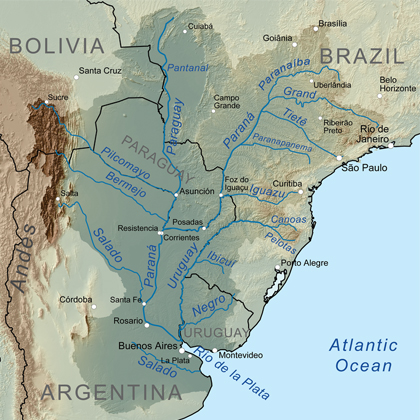
The Parana River, axis of the Rio del Plata basin [Wikimedia Commons–Kmusser]
|
The Itaipú dam (the second largest dam in the world and the first one in world production) is a binational dam, built by Paraguay and Brazil. It was the result of intense negotiations (which were not always easy), and it now produces an average of 90 million MWh (megawatt-hour) per year. Even so, there was not always harmony between Paraguay and Brazil: in 1872, disputes about borders began. After many unsuccessful agreements, it was agreed to flood the disputed territories and create a hydroelectric dam. The reluctance that the initiative raised in Argentina (because the regulation affected the flow that continued downstream until Río de la Plata) resulted in a three-way deal in 1979. In 1984, the dam became fully operational. Today it is managed by the Itaipú Binational Entity, a public-private company between Paraguay and Brazil, and supplies more than 16% of the total energy consumed in Brazil, and more than 75% of that consumed in Paraguay. Although the environmental impact was intense, Itaipú has promoted campaigns to maintain biological reserves and protect the fauna and flora. In addition, it has reforested large areas around the reservoir, and continues to ensure the quality of the water.
This is a clear example of the benefits that a reasonable and shared use of water can bring between countries that decide to cooperate. Thus, countries that are involved in some of the current controversies should look at these examples of behavior which, although not perfect, a lot can be learned from them.
Although water may be the origin of disputes between peoples and nations (as the cases mentioned), it also offers very advantageous opportunities (what happened in the Paraná River, or in the Nile) for countries that manage to cooperate. This cooperation, initiated to avoid conflicts over water, can lead to new stages of harmony and strengthen commercial, political and security relations. It is vital to show how an attitude of predisposition to negotiate and cooperate will always have positive consequences for countries that share river flows.